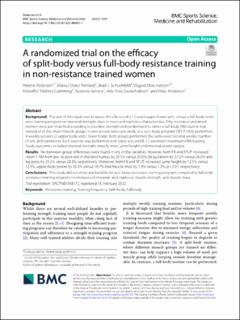| dc.contributor.author | Pedersen, Helene | |
| dc.contributor.author | Fimland, Marius Steiro | |
| dc.contributor.author | Schoenfeld, Brad J | |
| dc.contributor.author | Iversen, Vegard Moe | |
| dc.contributor.author | Cumming, Kristoffer Toldnes | |
| dc.contributor.author | Jensen, Susanne | |
| dc.contributor.author | Sæterbakken, Atle Hole | |
| dc.contributor.author | Andersen, Vidar | |
| dc.date.accessioned | 2022-09-29T09:41:17Z | |
| dc.date.available | 2022-09-29T09:41:17Z | |
| dc.date.created | 2022-05-30T15:11:39Z | |
| dc.date.issued | 2022 | |
| dc.identifier.citation | Pedersen, H., Fimland, M. S., Schoenfeld, B. J., Iversen, V. M., Cumming, K. T., Jensen, S., Saeterbakken, A. H., & Andersen, V. (2022). A randomized trial on the efficacy of split-body versus full-body resistance training in non-resistance trained women. BMC Sports Science, Medicine and Rehabilitation, 14(1):87. | en_US |
| dc.identifier.issn | 2052-1847 | |
| dc.identifier.uri | https://hdl.handle.net/11250/3022506 | |
| dc.description.abstract | Background
The aim of this study was to assess the efficacy of a 12-week upper/lower split- versus a full-body resistance training program on maximal strength, muscle mass and explosive characteristics. Fifty resistance untrained women were pair-matched according to baseline strength and randomized to either a full-body (FB) routine that trained all of the major muscle groups in one session twice per week, or a split-body program (SPLIT) that performed 4 weekly sessions (2 upper body and 2 lower body). Both groups performed the same exercises and weekly number of sets and repetitions. Each exercise was performed with three sets and 8–12 repetition maximum (RM) loading. Study outcomes included maximal strength, muscle mass, jump height and maximal power output.
Results
No between-group differences were found in any of the variables. However, both FB and SPLIT increased mean 1-RM from pre- to post-test in the bench press by 25.5% versus 30.0%, lat pulldown by 27.2% versus 26.0% and leg press by 29.2% versus 28.3%, respectively. Moreover, both FB and SPLIT increased jump height by 12.5% versus 12.5%, upper-body power by 20.3% versus 16.7% and muscle mass by 1.9% versus 1.7%, p < 0.01, respectively.
Conclusions
This study did not show any benefits for split-body resistance-training program compared to full-body resistance training program on measures of maximal- and explosive muscle strength, and muscle mass. | en_US |
| dc.language.iso | eng | en_US |
| dc.publisher | BMC | en_US |
| dc.rights | Navngivelse 4.0 Internasjonal | * |
| dc.rights.uri | http://creativecommons.org/licenses/by/4.0/deed.no | * |
| dc.title | A randomized trial on the efficacy of split-body versus full-body resistance training in non-resistance trained women | en_US |
| dc.type | Peer reviewed | en_US |
| dc.type | Journal article | en_US |
| dc.description.version | publishedVersion | en_US |
| dc.rights.holder | © The Author(s) 2022. | en_US |
| dc.source.volume | 14 | en_US |
| dc.source.journal | BMC sports science, medicine and rehabilitation | en_US |
| dc.source.issue | 1 | en_US |
| dc.identifier.doi | 10.1186/s13102-022-00481-7 | |
| dc.identifier.cristin | 2028181 | |
| dc.source.articlenumber | 87 | en_US |
| cristin.ispublished | true | |
| cristin.fulltext | original | |
| cristin.qualitycode | 1 | |

